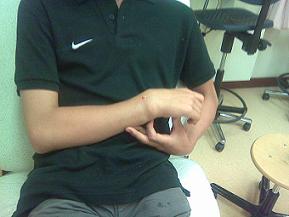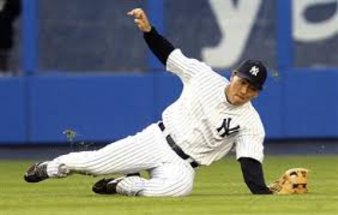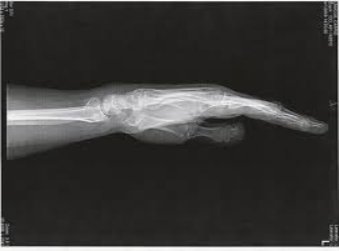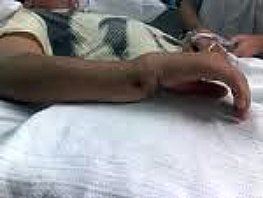|
Wrist FracturesOf all wrist fractures, the Colle’s variety is easily the most commonly encountered wrist injuries in adults, and especially those with any level of osteoporosis, or thinning of the bones. This injury type typically results from a fall onto the outstretched arm, causing the hand and wrist to dorsiflex, or, bend backwards
The fracture line is usually seen running transverse, or across, the distal end of the radius bone (the end closest to the hand). It can present as a "simple" injury with essentially one large fragment; the end-piece of the radius, or as a comminuted fracture (see “fracture types” page) with several fragments.
Looking at this x-ray, you can see the distal fracture fragment; the end-piece of the radius bone, is angled backwards towards the backside of the arm, this is called "dorsal angulation" and a classic sign of a Colle's fracture.
Check out the arm deformity in this picture. It demonstrates the familiar backward angle, or “dorsal angulation” of the distal fragment in Colle’s injury type. This visible deformity is also known as the “dinner fork” deformity as it resembles the side view of a dinner fork.
Carpal bones are the small bones of the hand adjacent to the wrist. The longer bones of the hand are called metacarpals. This injury is seen most frequently among active young adults.
Leave Wrist Fractures, Go to Fractures
|

"We hope you enjoy your journey through Bone and Joint Pain.com"
 Additionally, this injury is often accompanied by an ancillary small injury to the very tip of the ulna (forearm) bone called the ulnar styloid. In reality, this injury is more like a ligament injury or “avulsion fracture”, in which case the ulnar ligament is stretched so tightly that it literally “pulls” a small piece of bone away from its attachment.
Additionally, this injury is often accompanied by an ancillary small injury to the very tip of the ulna (forearm) bone called the ulnar styloid. In reality, this injury is more like a ligament injury or “avulsion fracture”, in which case the ulnar ligament is stretched so tightly that it literally “pulls” a small piece of bone away from its attachment.



